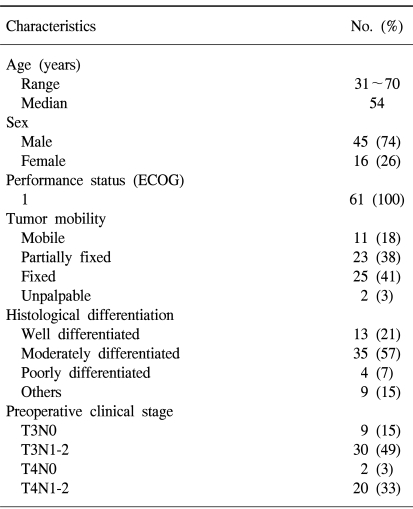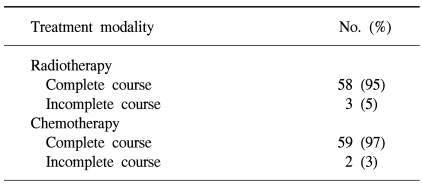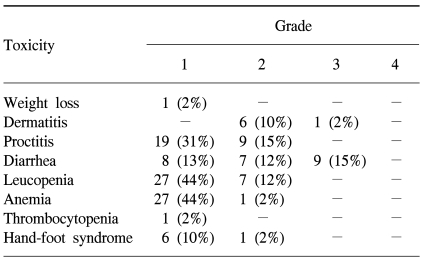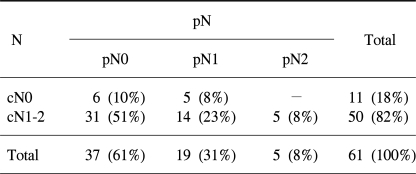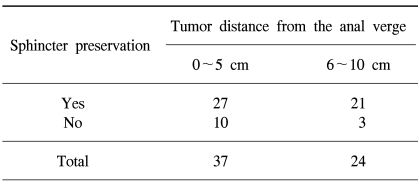Abstract
Purpose
Capecitabine is an attractive oral chemotherapeutic agent that has a radiosensitizing effect and tumor-selectivity. This study was performed to evaluate the efficacy and toxicity of preoperative chemoradiation therapy, when used with oral capecitabine, for locally advanced rectal cancer.
Materials and Methods
A prospective phase II trial of preoperative chemoradiation for locally advanced adenocarcinomas of the lower two-thirds of the rectum was conducted. A radiation dose of 50 Gy over five weeks and a daily dose of 1650 mg/m2 capecitabine in two potions was administered during the entire course of radiation therapy. Surgery was performed with standardized total mesorectal excision four to six weeks after completion of the chemoradiation.
Results
Between January 2002 and September 2003, 61 patients were enrolled onto this prospective phase II trial. The pretreatment clinical stages were T3 in 64% (n=39), T4 in 36% (n=22) and N1-2 in 82% (n=50) of these patients. Fifty-six (92%) patients completed the chemoradiation as initially planned and a complete resection performed in 58 (95%). Down-staging was observed in 45 patients (74%) and a pathologic complete response in 6 (10%). Among the 37 patients with tumors located within 5 cm from the anal verge on colonoscopy, 27 (73%) underwent a sphincter-preserving procedure. No grade 3 and 4 proctitis or hematological toxicities were observed.
Conclusion
Preoperative chemoradiation therapy with capecitabine achieved encouraging rates of tumor downstaging and sphincter preservation, with a low toxicity profile. This combined modality can be regarded as a safe and effective treatment for locally advanced rectal cancer.
Keywords: Rectal cancer, Preoperative, Chemoradiotherapy, Capecitabine
INTRODUCTION
Preoperative radiation therapy, as a neoadjuvant treatment of rectal cancer, has been widely used in Europe, resulting in improvements of local recurrence, survival rates and preservation of the sphincter in low-lying rectal cancer. A recent metaanalysis has confirmed the advantages of preoperative radiation therapy, and a few randomized trials have added evidence of its efficiency for local control over that of postoperative treatment (1,2). Recently, the concurrent use of chemotherapy was introduced as a preoperative treatment for radiosensitization and spatial cooperation (3~5), and has been proved in postoperative adjuvant therapy through many randomized trials (6,7). Although, whether preoperative chemoradiotherapy is superior to radiotherapy alone remains a controversial issue, but one preliminary result from a European trial suggested that preoperative chemoradiation was well tolerated, with treatment morbidity comparable to postoperative chemoradiation (8).
The most widely used chemotherapeutic agent for the colorectal cancer has been 5-FU, and numerous attempts have been made to improve its efficacy. Through these attempts, biomodulation with leucovorin or levamisole was demonstrated to be ineffective in rectal cancer (9), but a protracted infusion of 5-FU was superior to a bolus injection (7,10). Although the clinical data suggest that a protracted infusion of 5-FU was more effective and tolerated than a bolus administration (10), there were many problems associated with protracted infusion; for example, the use of an ambulatory infusion pump, central venous catheter, infection, thrombosis, intensive labor and high cost. Several new oral chemotherapeutic agents, including capecitabine, have recently been introduced for the treatment of colorectal cancer. Theoretically, oral chemotherapy may mimic the effect of a protracted infusion of 5-FU, but without the complications mentioned above. Moreover, it is more convenient and preferential for patients (11). Capecitabine is a tumor- selective fluoropyrimidine carbamate for achieving a higher intratumoral 5-FU level, with a lower systemic toxicity than intravenous administration of 5-FU (12). It passes, intact, through the intestinal mucosa, where it is preferentially converted to 5-FU by thymidine phosphorylase in tumor tissue (13,14). Moreover, experimental data using human cancer xenografts have shown the up-regulation of thymidine phosphorylase by radiation (15). In two randomized phase III trials for metastatic colorectal cancer, capecitabine showed a superior overall response rate and safety profile compared with 5-FU/lecovorinin (16~18).
At present, the results of the concurrent use of capecitabine and radiation for locally advanced rectal cancer are rare. In a phase I study of capecitabine chemoradiation therapy for locally advanced rectal cancer, the recommended dose for the phase II trial was 825 mg/m2/day, with a promising response (19). In view of this encouraging result, a prospective phase II trial was performed to evaluate the effect of preoperative chemoradiation therapy with oral capecitabine, in terms of tumor response, sphincter preservation and toxicity, for locally advanced rectal cancer.
MATERIALS AND METHODS
1) Eligibility
The eligibility criteria for this study were as follows: (a) histologically proven rectal adenocarcinoma; (b) distal margin of tumor located within 10 cm from the anal verge on colonofiberscopy (CFS); (c) extension of the primary tumor through the bowel wall, or positive lymph nodes without evidence of any distant metastatic disease (T3-4, or N positive and M0) on endorectal ultrasonography (EUS) and computerized tomography (CT) scan; (d) age 18~75 years; (e) ECOG performance status of 2 or below; (f) adequate bone marrow reserve (white blood cell count ≥4,000/mm3, platelet count ≥100,000/mm3, hemoglobin ≥10 gm/dl); (g) adequate renal function (serum creatinine level ≤1.5 mg/dl, calculated creatinine clearance ≥50 mg/min); (h) adequate liver function (liver transaminase levels ≤3 times the upper normal limit, serum bilirubine ≤1.5 mg/dl); (i) patients must have no psychological, familial, sociological or geographical conditions that would prevent medical follow-up or compliance with this study; (j) patients must be able to understand the study and have given their written informed consent to participate in the study. The exclusion criteria included: (a) a tumor type other than an adenocarcinoma; (b) past or concurrent history of a malignant neoplasm, with the exception of a curatively treated non-melanoma skin cancer or in situ carcinoma of the cervix; (c) pregnant or lactating women, women of childbearing potential employing inadequate contraception; (d) familial history of colorectal cancer. This study was approved by the Institutional Review Board for Human Research.
2) Pretreatment evaluation and monitoring during treatment
The pretreatment evaluations included a complete medical history, physical examination, complete blood count, serum biochemistry, CEA, chest x-ray, CFS, abdominal/pelvic CT, EUS, whole body bone scan (in case of CEA >40 ng/ml) and chest CT (in case of CEA >20 ng/ml). Clinical staging was determined according to the abdominal/pelvic CT and EUS findings using the 2001 AJCC TNM cancer staging.
During the chemoradiation therapy, all patients were interviewed and examined weekly for the evaluation of treatment-related toxicity and compliance. Complete blood count, chemistry and a documentation of body weight were checked weekly.
3) Treatment
All patients received preoperative radiation therapy for 5 weeks, with concurrent use of capecitabine, and underwent a surgical resection 4~6 weeks after completion of the chemoradiation. The total scheme of treatment is illustrated in Fig. 1.
Fig. 1.
Overall treatment scheme.
(1) Radiation therapy
All patients received pelvic radiotherapy through 3 (posterior to anterior and two laterals) or 4 fields (anterior to posterior, posterior to anterior and two laterals) with a megavoltage beam (6 or 15 MV) from a linear accelerator. Radiotherapy was delivered 5 days per week, covering every radiation field. The treatment volume encompassed the primary tumor, surrounding soft tissue, internal iliac and presacral nodes. The lateral borders of the radiation field were 1.5~2 cm lateral to the widest bony margin of the true pelvic walls. The superior border of the radiation field was at the bottom of L5, and inferiorly the field was extended about 3 cm distal to the tumor. On the lateral fields, the anterior border of the field was posterior to the symphysis or at least 3 cm anterior to the tumor, and the posterior border was located at 1 cm behind the posterior surface of the sacrum, including the whole sacrum. The whole pelvis received 46 Gy, in 2 Gy fractions, with an additional boost dose of 4 Gy in two fractions. The treatment volume for the boost radiotherapy encompassed the primary tumor and adjacent lymph nodes, with 3 cm longitudinal and 2 cm lateral margins.
(2) Chemotherapy
The chemotherapy was begun on day 1 of the radiotherapy. Capecitabine was administered orally at a dose of 1650 mg/m2/day divided into two doses for the whole period of radiotherapy, without a weekend break. The adjuvant chemotherapy following surgical resection consisted of 4 cycles of capecitabine (2500 mg/m2 daily for 14 days, followed by 1 weeks rest after each cycle). Anti-emetics were prescribed routinely for the prevention of nausea and vomiting. Dose modification of the capecitabine was as follows: a) 25% dose reduction for grade 1 hematological or grade 2 non-hematological toxicities; b) 50% dose reduction for grade 2 hematological or grade 3 non-hematological toxicities; c) complete interrupted in cases of grades 3 or 4 hematological or grade 4 non-hematological toxicities.
(3) Surgery
Patients were re-evaluated 3~4 weeks after completion of the chemoradiation therapy just before surgery. The same procedures as in the initial work-ups were repeated to determine operability and resectability. Surgery was performed at 4 to 6 weeks following the completion of chemoradiation therapy following the re-evaluation. The surgical type was finally determined at the time of operation, according to the location and extent of the tumor. All surgical technique included standard total mesorectal excision (TME) and principal lymph node sampling, with limited dissection, namely, in the R2 and R3 range (20).
4) Treatment evaluation
During the chemoradiation therapy, the acute toxicity was assessed according to the National Cancer Institute Common Toxicity Criteria version 2.0. Evaluation of the response to preoperative chemoradiation therapy was assessed based on a pathologic examination. If the pathologist and surgeon confirmed a pathologically tumor-free margin, the surgery was regarded as a complete resection. After surgery, pathologic TNM staging was performed according to the 2001 AJCC staging system and compared to the clinical stage. Perioperative complications included events within 60 days of surgery.
RESULTS
1) Patient characteristics
Between January 2002 and September 2003, 61 patients with locally advanced rectal cancer were enrolled in this study. The characteristics of patients are summarized in Table 1. The ages ranged from 31 to 70 years (median age, 54 years), with a male to female ratio of 2.8. All patients were of good performance status (ECOG 1). Forty-eight patients (79%) had tethered or fixed tumor mobilities on the digital rectal examination prior to chemoradiation therapy, and the distance from the anal verge to the distal end of the tumor ranged between 1 and 10 cm (median distance, 5 cm). The clinical stages based on the abdominal/pelvic CT and EUS findings were T3N0 in 15% (n=9), T3N1-2 in 49% (n=30), T4N0 in 3% (n=2) and T4N1-2 in 33% (n=20) of cases.
Table 1.
Patient characteristics
2) Treatment compliance and toxicity
Fifty-six patients (92%) completed the initially planned overall preoperative chemoradiation therapy, and all patients underwent surgical resection with curative intention. Fifty-nine patients (97%) successfully completed the planned chemotherapy. The dose of chemotherapy was reduced due to stomatitis in one patient and leucopenia in another. Because hematological and non-hematological toxicities in the other patients were observed at the end of concurrent chemoradiation therapy, and recovered with supportive care, the capecitabine dose was not modified as suggested on our initial protocol mentioned above. Fifty-eight patients (95%) received a radiation dose of 50 Gy, but the planned radiation dose was not delivered in two patients (46 Gy and 48 Gy) due to personal affairs unrelated to treatment. One patient developed an intestinal obstruction during treatment, so the radiation therapy was completed after a dose of 44 Gy. The radiation therapy was not interrupted for more than 2 days in relation to treatment. The treatment compliance is summarized in Table 2.
Table 2.
Treatment compliance
Preoperative chemoradiation therapy was relatively well tolerated in most patients, and no treatment-related mortality was observed. A weight loss of more than 5% of the pretreatment body weight was observed in only one patient. The main acute toxicity related to treatment was gastrointestinal toxicity. Although nine patients (15%) developed grade 3 diarrhea, they all recovered spontaneously with supportive management, and no grade 3 or 4 proctitis was observed. There was no grade 3 or higher hematological toxicity or neutropenia- related infection. Seven patients (11%) developed grade 1 or 2 hand-foot syndrome. The acute toxicity profile is given in Table 3. As a perioperative complication, one patient developed an anastomotic leakage and underwent transient diversion procedure, but there were no severe perioperative complications requiring major intervention or surgical mortality.
Table 3.
Acute toxicity
3) Tumor response and sphincter preservation
A complete resection, confirmed by pathologic examination, was performed in 58 patients (95%). There were two patients whose tumors could not be resected completely (R1 resection), and one patient received a palliative rectal resection due to an unresectable extensive retroperitoneal infiltration with ureter metastasis (Table 4). Although liver metastasis was detected in four patients at the time of the preoperative evaluation or operation, a complete surgical resection was performed in all four.
Table 4.
Extent of resection
When the clinical pretreatment stage was compared with the pathologic results, downstaging in the T and N stages was possible in 36 (59%) and 31 patients (51%), respectively. The overall downstaging rate, including both T and N stages, was 74% (45/61). The distribution of pathologic stage is shown in Tables 5 & 6. Complete disappearance of the primary tumor and lymph node on the pathologic specimen (pCR) was observed in 6 patients (10%) and one patient showed pCR of primary tumor, but had residual tumor cells in the regional node. There were 5 patients whose residual tumor was microscopic (≤2 mm in greatest dimension), which if included in the gross CR (gCR), the overall gCR rate was 18% (11/61).
Table 5.
Distribution of pathologic T stage in each clinical T stage
Table 6.
Distribution of pathologic N stage in each clinical N stage
A sphincter preservation operation was performed in 48 patients (79%), but no patient required a pelvic exenteration for curative resection. Of the 37 patients with a tumor located within 5 cm from the anal verge, sphincter preservation was possible in 27 (73%). The results of sphincter preservation in relation to the distance of the tumor from the anal verge are summarized in Table 7.
Table 7.
Sphincter preservation
DISCUSSION
Preoperative chemoradiation therapy for rectal cancer, with a conventional fractionation schedule, demonstrated considerable downstaging and sphincter preservation rates (3~5). Most of these trials adopted 5-FU, with or without leucovorin, by a bolus or continuous infusion method. Although preoperative radiation with 5-FU for rectal cancer was promising, there is no established chemotherapeutic regimen for a preoperative combined modality in rectal cancer. Oral chemotherapy is convenient to administer, with advantage in terms of cost reduction. Experimental data have shown that oral prodrug of 5-FU provided similar pharmacokinetic characteristics to that of protracted infusion (21), and was more advantageous in terms of the complications associated with protracted infusion, such as venous thrombosis or infection. For these reasons, oral capecitabine was adopted for the development of a regimen for locally advanced rectal cancer.
There have only been a few reports of chemoradiation therapy, with oral capecitabine for rectal cancer, in the literature. Dunst (19) reported a phase I trial in adjuvant, neoadjuvant and palliative settings, with a total radiation dose of 50.4 Gy. The recommended dose of capecitabine for a phase II trial was 825 mg/m2/day. Acute toxicities, such as bowel irritation and skin toxicity, within radiation fields were not increased when the recommended dose level was maintained. The response rate in a neoadjuvant setting was promising, and results with 50.4 Gy radiation therapy, with two cycles of capecitabine (1650 mg/m2/day) and low dose leucovorin (20 mg/m2/day), have been reported for locally advanced rectal cancer (22). A total of 45 patients were enrolled in the aforementioned study, with 9% having a clinical T4 disease. Downstaging was observed in 63% of T-stage and 90% of N-stage patients, with a pathologic complete response rate in 31%. Sphincter preservation was achieved in 72% of patients with a tumor located 5 cm or less from the anal verge. There was no grade 3 or higher hematological toxicity. Grade 3 diarrhea and hand-foot syndrome were observed in 4 and 7% of patients, respectively. Kocakova (23) recently reported the preliminary result of 50.4 Gy radiation therapy with 1650 mg/m2 capecitabine in 34 locally advanced rectal cancer patients. Although the proportion with those with a clinical T4 disease was not reported, all patients were downstaged with the preoperative chemoradiation therapy. The sphincter preservation rate for tumors located within 10 cm from the anal verge was 76%, with a pathologic complete response rate of 21%. Also, Dunst (24) reported a phase II trial with the same regimen as their previous phase I trial, with 45 patients enrolled at the time of this report. The proportion with a T4 disease was 50%, with a downstaging rate for the primary tumor of 72%. A clinically complete or partial remission was achieved in 81% of patients, with a similar rate of complete resection (R0) to other reports. The observed grade 2 or greater toxicities were leucopenia (22%), anemia (13%), skin (15%) and diarrhea (17%).
In previous studies of preoperative chemoradiation therapy using 5-FU, the pathologic complete remission rates varied from 11 to 31% (3~5), which are comparable with the results of capecitabine (22~24). Although it is difficult to directly compare the response rates between reports on preoperative chemoradiation therapy, due to the differences in clinical staging evaluation and the pretreatment tumor characteristics, the pathologic complete response rate in the current trial seems to be inferior to those of previous reports, which may have been due to the higher proportion (36%) of a clinical T4 disease. The downstaging effect and sphincter preservation rate in this study were similar to those of other reports (4,5,22~24).
Preliminary trials using capecitabine with radiotherapy have reported lower complication rates than with intravenous 5-FU-based chemotherapy (19,22~24). Similarly, the preoperative chemoradiation therapy was well tolerated in most of our trial patients, with excellent treatment compliance. All acute toxicities recovered with supportive care, with no delay of radiation therapy of more than 2 days. There was no treatment-related hospitalization or death related to the preoperative chemoradiation therapy. Although grade 3 diarrhea was more common, the overall toxicity profile was comparable to that of other reports (22~24). During the perioperative period, one anastomotic leakage developed, but no other serious perioperative complications were observed. Also, the overall postoperative complication profile was comparable to that of our experience of postoperative radiation therapy (25).
CONCLUSIONS
Preoperative chemoradiation therapy for locally advanced rectal cancer using oral capecitabine achieved encouraging rates of tumor downstaging and sphincter preservation. In addition, the acute toxicity in this trial was acceptable. This combined modality can be regarded as a safe, effective and convenient treatment for locally advanced rectal cancer.
References
- 1.Camma C, Giunta M, Fiorica F, Pagliaro L, Craxi A, Cottone M. Preoperative radiotherapy for resectable rectal cancer: A meta-analysis. JAMA. 2000;284:1008–1015. doi: 10.1001/jama.284.8.1008. [DOI] [PubMed] [Google Scholar]
- 2.Glimelius B, Isacsson U, Jung B, Pahlman L. Radiotherapy in addition to radical surgery in rectal cancer: evidence for a dose-response effect favoring preoperative treatment. Int J Radiat Oncol Biol Phys. 1997;37:281–287. doi: 10.1016/s0360-3016(96)00510-x. [DOI] [PubMed] [Google Scholar]
- 3.Minsky BD, Cohen AM, Enker WE, Saltz L, Guillem JG, Paty PB, et al. Preoperative 5-FU, low-dose leucovorin, and radiation therapy for locally advanced and unresectable rectal cancer. Int J Radiat Oncol Biol Phys. 1997;37:289–295. doi: 10.1016/s0360-3016(96)00487-7. [DOI] [PubMed] [Google Scholar]
- 4.Janjan NA, Khoo VS, Abbruzzese J, Pazdur R, Dubrow R, Cleary KR, et al. Tumor downstaging and sphincter preservation with preoperative chemoradiation in locally advanced rectal cancer: the M. D. Anderson Cancer Center experience. Int J Radiat Oncol Biol Phys. 1999;44:1027–1038. doi: 10.1016/s0360-3016(99)00099-1. [DOI] [PubMed] [Google Scholar]
- 5.Janjan NA, Crane CN, Feig BW, Cleary K, Dubrow R, Curley SA, et al. Prospective trial of preoperative concomitant boost radiotherapy with continuous infusion 5-fluorouracil for locally advanced rectal cancer. Int J Radiat Oncol Biol Phys. 2000;47:713–718. doi: 10.1016/s0360-3016(00)00418-1. [DOI] [PubMed] [Google Scholar]
- 6.Krook JE, Moertel CG, Gunderson LL, Wieand HS, Collins RT, Beart RW, et al. Effective surgical adjuvant therapy for high-risk rectal carcinoma. N Engl J Med. 1991;324:709–715. doi: 10.1056/NEJM199103143241101. [DOI] [PubMed] [Google Scholar]
- 7.O'Connell MJ, Martenson JA, Wieand HS, Krook JE, Macdonald JS, Haller DG, et al. Improving adjuvant therapy for rectal cancer by combining protracted-infusion fluorouracil with radiation therapy after curative surgery. N Engl J Med. 1994;331:502–507. doi: 10.1056/NEJM199408253310803. [DOI] [PubMed] [Google Scholar]
- 8.Sauer R, Fietkau R, Wittekind C, Martus P, Rodel C, Hohenberger W, et al. Adjuvant versus neoadjuvant radiochemotherapy for locally advanced rectal cancer. A progress report of a phase-III randomized trial (protocol CAO/ARO/AIO-94) Strahlenther Onkol. 2001;177:173–181. doi: 10.1007/pl00002396. [DOI] [PubMed] [Google Scholar]
- 9.Tepper JE, O'Connell M, Niedzwiecki D, Hollis DR, Benson AB, 3rd, Cummings B, et al. Adjuvant therapy in rectal cancer: analysis of stage, sex, and local control-final report of intergroup 0114. J Clin Oncol. 2002;20:1744–1750. doi: 10.1200/JCO.2002.07.132. [DOI] [PubMed] [Google Scholar]
- 10.Meta-analysis Group In Cancer. Efficacy of intravenous continuous infusion of fluorouracil compared with bolus administration in advanced colorectal cancer. J Clin Oncol. 1998;16:301–308. doi: 10.1200/JCO.1998.16.1.301. [DOI] [PubMed] [Google Scholar]
- 11.Liu G, Franssen E, Fitch MI, Warner E. Patient preferences for oral versus intravenous palliative chemotherapy. J Clin Oncol. 1997;15:110–115. doi: 10.1200/JCO.1997.15.1.110. [DOI] [PubMed] [Google Scholar]
- 12.Shimma N, Umeda I, Arasaki M, Murasaki C, Masubuchi K, Kohchi Y, et al. The design and synthesis of a new tumorselective fluoropyrimidine carbamate, capecitabine. Bioorg Med Chem. 2000;8:1697–1706. doi: 10.1016/s0968-0896(00)00087-0. [DOI] [PubMed] [Google Scholar]
- 13.Schuller J, Cassidy J, Dumont E, Roos B, Durston S, Banken L, et al. Preferential activation of capecitabine in tumor following oral administration to colorectal cancer patients. Cancer Chemother Pharmacol. 2000;45:291–297. doi: 10.1007/s002800050043. [DOI] [PubMed] [Google Scholar]
- 14.Miwa M, Ura M, Nishida M, Sawada N, Ishikawa T, Mori K, et al. Design of a novel oral fluoropyrimidine carbamate, capecitabine, which generates 5-fluorouracil selectively in tumours by enzymes concentrated in human liver and cancer tissue. Eur J Cancer. 1998;34:1274–1281. doi: 10.1016/s0959-8049(98)00058-6. [DOI] [PubMed] [Google Scholar]
- 15.Sawada N, Ishikawa T, Sekiguchi F, Tanaka Y, Ishitsuka H. X-ray irradiation induces thymidine phosphorylase and enhances the efficacy of capecitabine (Xeloda) in human cancer xenografts. Clin Cancer Res. 1999;5:2948–2953. [PubMed] [Google Scholar]
- 16.Van Cutsem E, Twelves C, Cassidy J, Allman D, Bajetta E, Boyer M, et al. Oral capecitabine compared with intravenous fluorouracil plus leucovorin in patients with metastatic colorectal cancer: results of a large phase III study. J Clin Oncol. 2001;19:4097–4106. doi: 10.1200/JCO.2001.19.21.4097. [DOI] [PubMed] [Google Scholar]
- 17.Hoff PM, Ansari R, Batist G, Cox J, Kocha W, Kuperminc M, et al. Comparison of oral capecitabine versus intravenous fluorouracil plus leucovorin as first-line treatment in 605 patients with metastatic colorectal cancer: Results of a randomized phase iii study. J Clin Oncol. 2001;19:2282–2292. doi: 10.1200/JCO.2001.19.8.2282. [DOI] [PubMed] [Google Scholar]
- 18.Twelves C Xeloda Colorectal Cancer Group. Capecitabine as first-line treatment in colorectal cancer. Pooled data from two large, phase III trials. Eur J Cancer. 2002;38:15–20. doi: 10.1016/s0959-8049(01)00415-4. [DOI] [PubMed] [Google Scholar]
- 19.Dunst J, Reese T, Sutter T, Zuhlke H, Hinke A, Kolling-Schlebusch K, et al. Phase I trial evaluating the concurrent combination of radiotherapy and capecitabine in rectal cancer. J Clin Oncol. 2002;20:3983–3991. doi: 10.1200/JCO.2002.02.049. [DOI] [PubMed] [Google Scholar]
- 20.Kim JC, Lee KH, Yu CS, Kim HC, Kim JR, Chang HM, et al. The clinicopathological significance of inferior mesenteric lymph node metastasis in colorectal cancer. Eur J Surg Oncol. 2004;30:271–279. doi: 10.1016/j.ejso.2003.12.002. [DOI] [PubMed] [Google Scholar]
- 21.Ho DH, Pazdur R, Covington W, Brown N, Huo YY, Lassere Y, et al. Comparison of 5-fluorouracil pharmacokinetics in patients receiving continuous 5-fluorouracil infusion and oral uracil plus N1-(2'-tetrahydrofuryl)-5-fluorouracil. Clin Cancer Res. 1998;4:2085–2088. [PubMed] [Google Scholar]
- 22.Kim JS, Kim JS, Cho MJ, Song KS, Yoon WH. Preoperative chemoradiation using oral capecitabine in locally advanced rectal cancer. Int J Radiat Oncol Biol Phys. 2002;54:403–408. doi: 10.1016/s0360-3016(02)02856-0. [DOI] [PubMed] [Google Scholar]
- 23.Kocakova I, Spelda S, Svoboda M, Vyzula R, Kocak I, Brancikova D, et al. Combined therapy of locally advanced rectal adenocarcinoma with capecitabine and concurrent radiotherapy. Proc Am Soc Clin Oncol. 2003;22:322. [Google Scholar]
- 24.Dunst J, Reese T, Hoelscher T, Rudat V, Wulf J, Mose S, et al. Capecitabine combined with radiotherapy as neoadjuvant treatment of locally advanced rectal cancer. Proc Am Soc Clin Oncol. 2003;22:277. [Google Scholar]
- 25.Lee JH, Lee JH, Ahn JH, Bahng H, Kim TW, Kang YK, et al. Randomized trial of postoperative adjuvant therapy in stage ii and iii rectal cancer to define the optimal sequence of chemotherapy and radiotherapy: a preliminary report. J Clin Oncol. 2002;20:1751–1758. doi: 10.1200/JCO.2002.07.037. [DOI] [PubMed] [Google Scholar]




